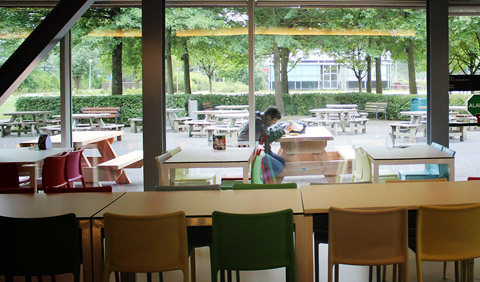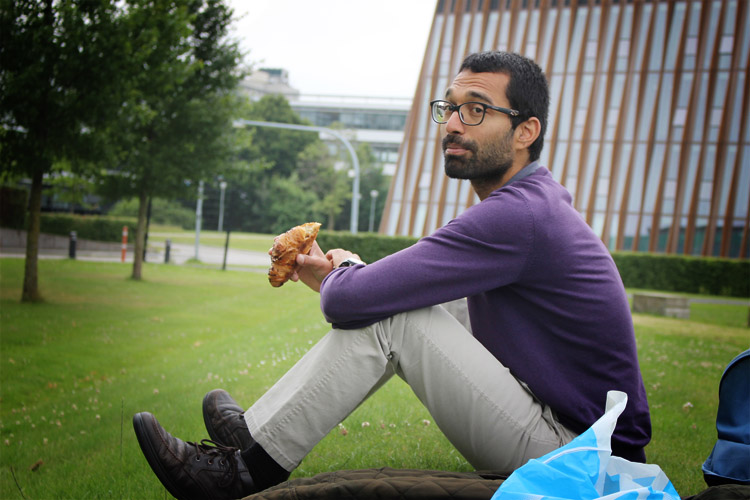
Students avoid RUG food
The canteen debacle
What to improve according to students?
Better prices
More variety and warm meal options
Better vegan and vegetarian options
Product labelling for students with food allergies (who cannot currently risk RUG canteens)
Restocking; many students who are used to eating later in the day say the canteen is usually wiped out by the time they get there
Karabbe Das throws cumin seeds into a pan of hot oil. When they split, she adds several squares of fresh paneer cheese and a pinch of diced turmeric and chili. She fries tomatoes and onions in the hot pan until they are ‘a bit mushy’ and then sprinkles coriander over everything. Lunch is ready for this Indian student.
Karabbe is not the only one who loses some sleep every morning so she can pack a lunch. The UKrant spoke to 400 students – Dutch and international students alike – and over half of them prefer making their lunches at home over eating at a RUG canteen. What’s so bad about cafeteria food?
‘It’s just horrible, ridiculously expensive. There’s not much more than bread, soup or fried snacks’, says Francesca Cadoni, an Italian Masters student.
‘Bad to terrible’
Some canteen prices have been lowered in response to student complaints, but over 57 percent of respondents still rate RUG canteen prices ‘bad’ or ‘terrible’. Around 40 percent have the same low opinion of the variety of options offered in the canteens.
Nearly 35 percent of respondents say they never eat at RUG canteens. Instead, many students – over 40 percent – prefer to spend their lunch money at the supermarket, a cafe, or even through illegal WeChat groups, like the hundreds of Chinese students who secretly order fresh meals every day on Zernike campus.
Over 60 percent of respondents say they would gladly buy food through an unlicensed vendor if it was better and cheaper than the canteens.
Notably, students don’t really have a problem with the quality of canteen food, which nearly 80 percent rated ‘fair to good’.
High Prices
But decent food shouldn’t be so expensive, students say. ‘If someone goes to the canteen every day, it is too expensive. Canteens should be affordable to support students in their daily life’, a respondent wrote.
The hot meal of the day at Bernoulliborg costs 5.50 euros, whether it contains meat or not. This month, one vegan ‘alternative’ to fish and chips was onion rings with chips and salad.
In Germany for around 2.50 euros I got a huge, warm meal. Here I get a coffee
‘In Germany for around 2.50 euros I got a huge, warm meal. Here I get a coffee. There is an Albert Heijn, which helps on variety at least, but prices are high as well’, says PhD student Monique Bernandes.
‘In Finland we could buy a warm lunch for 2 euros, but here a bun and cheese is around 1 euro. The prices are exorbitant’, another student writes.
Poor variety
The lack of variety is another common complaint. Vegetarians and vegans rarely have more than one option. ‘It is always the exact same food and not a real meal. When we have lunch meetings with my colleagues I have to bring my own food if I don’t want to eat a boring sandwich’, says Mel Schnijderson, who works at the RUG. She would rather go to one of the more expensive cafés around the city center than the Harmony canteen.
Indian student Veena Suresh agrees: ‘It’s the same food every day. As a vegan, three euros for a couple slices of bread, some tomato, and a few slices of cucumber? Pretty steep, if you ask me’.
International students seem especially disappointed by the lack of variety. The typical cold Dutch lunch of a cheese sandwich and a milk or yogurt just leaves something to be desired.
Warm meal
‘In Colombia lunch is always a warm meal. It has soup, salad, protein and carbohydrates like rice or potatoes. All this is accompanied by natural fruit juice and topped with dessert and a cup of coffee’, says PhD student Edgar Yañez, wistfully.
‘Lunch in India is usually rice-based and a warm meal, so it’s quite different. But I don’t expect that to be provided here, I would just like sandwiches or soups that aren’t so expensive’, says Suresh.
Even Dutch students are underwhelmed by canteen food options, and just pack their own lunches instead. ‘What is wrong with making your own lunch to take with you?’ asks Groningen local Arjan Undernetha in a Facebook comment thread bemoaning the woes of university food. ‘It’s the best you can get. I always take my own Greek yogurt with fruits, nuts, seeds and some granola.’
The university is highly internationalized, but the canteen is most certainly not
‘Delicious’, replies Cadoni. ‘But in most countries, that would be breakfast. When you don’t have the time to prepare something yourself it would be nice if the university could offer proper food that is not a rip-off and is friendly to internationals’, she says. ‘The university is highly internationalized, but the canteen is most certainly not.’
A history of poor reviews
On 2 January, 2018, the RUG hired an external catering company: Beijk-Chef Serveert. By the end of the month students had already submitted an online petition requesting better prices, quality, serving size, and sustainability of products offered.
The catering service promised to revise prices, increase portion sizes, and offer more vegan and vegetarian options. ‘At the request of staff and students the bowls for the salads will return. The cups for orange juice and smoothies will be bigger, as will the cappuccino cups at Illy Cafés’, states the response to the petition published on the RUG’s website.
Some prices for common items – like fruit and bread slices – were indeed lowered, generally by between 15 and 30 cents. The ‘watery soup’ stayed at 1 euro. But despite these concessions, students are still unhappy.
‘Last year with the old caterer there was a sandwich with vegan cheese that was great and not as expensive as the sandwiches they sell now’, says Suresh.
A common problem
The RUG isn’t the only Dutch university to face criticism for less-than-great cafeteria food. Four years ago, a satisfaction survey at Erasmus University Rotterdam (EUR) revealed that almost no one was happy with the food. EUR spokesperson Sandra van Beek says the university responded to those surprising findings by promptly hiring a better catering service.
The change helped. ‘At this moment food complaints are not an issue in Rotterdam’, says Van Beek.
Would the RUG ever administer a similar survey? University spokesperson Jorien Bakker says yes. ‘Bijk-Chef Serveert is now planning a satisfaction survey. They are starting in the next couple weeks, before the summer holidays. And in the fall, we will make a total examination.’
Until then, the Facebook page Food and drinks University of Groningen is rated 1.3 out of five stars, and the catering company Beijk-Chef Serveert has an even lower one star rating.


